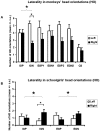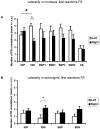Social and emotional values of sounds influence human (Homo sapiens) and non-human primate (Cercopithecus campbelli) auditory laterality
- PMID: 19609434
- PMCID: PMC2707001
- DOI: 10.1371/journal.pone.0006295
Social and emotional values of sounds influence human (Homo sapiens) and non-human primate (Cercopithecus campbelli) auditory laterality
Abstract
The last decades evidenced auditory laterality in vertebrates, offering new important insights for the understanding of the origin of human language. Factors such as the social (e.g. specificity, familiarity) and emotional value of sounds have been proved to influence hemispheric specialization. However, little is known about the crossed effect of these two factors in animals. In addition, human-animal comparative studies, using the same methodology, are rare. In our study, we adapted the head turn paradigm, a widely used non invasive method, on 8-9-year-old schoolgirls and on adult female Campbell's monkeys, by focusing on head and/or eye orientations in response to sound playbacks. We broadcast communicative signals (monkeys: calls, humans: speech) emitted by familiar individuals presenting distinct degrees of social value (female monkeys: conspecific group members vs heterospecific neighbours, human girls: from the same vs different classroom) and emotional value (monkeys: contact vs threat calls; humans: friendly vs aggressive intonation). We evidenced a crossed-categorical effect of social and emotional values in both species since only "negative" voices from same class/group members elicited a significant auditory laterality (Wilcoxon tests: monkeys, T = 0 p = 0.03; girls: T = 4.5 p = 0.03). Moreover, we found differences between species as a left and right hemisphere preference was found respectively in humans and monkeys. Furthermore while monkeys almost exclusively responded by turning their head, girls sometimes also just moved their eyes. This study supports theories defending differential roles played by the two hemispheres in primates' auditory laterality and evidenced that more systematic species comparisons are needed before raising evolutionary scenario. Moreover, the choice of sound stimuli and behavioural measures in such studies should be the focus of careful attention.
Conflict of interest statement
Figures


References
-
- Broca P. Remarques sur le siège de la faculté du langage articulé, suivies d'une observation d'aphémie (perte de la parole). Bul Soc Anat. 1861;6:330–357.
-
- Wernicke C. Der aphasische symptomencomplex: Eine psychologische studie auf anatomischer basis. Eggert GH, editor. Wernicke's works on aphasia: A sourcebook and review. 1874:91–145.
-
- Poremba A, Malloy M, Saunders RC, Carson RE, Herscovitch P, et al. Species-specific calls evoke asymmetric activity in the monkey's temporal poles. Nature. 2004;427:448–451. - PubMed
-
- Pell MD. Cerebral mechanisms for understanding emotional prosody in speech. Brain Lang. 2006;96:221–234. - PubMed
-
- Ley RG, Bryden MP. A dissociation of right and left hemispheric effects for recognizing emotional tone and verbal content. Brain cogn. 1982;1:3–9. - PubMed
Publication types
MeSH terms
LinkOut - more resources
Full Text Sources

